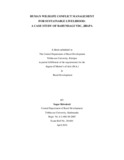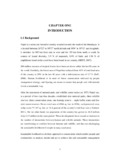Please use this identifier to cite or link to this item:
https://elibrary.tucl.edu.np/handle/123456789/2251| Title: | Human Wildlife Conflict Management for Sustainable Livelihood: A Case Study of Bahundagi VDC, Jhapa |
| Authors: | Siwakoti, Sagar |
| Keywords: | Wildlife;Management;Livelihood |
| Issue Date: | 2016 |
| Publisher: | Central Department of Rural Development |
| Abstract: | Human-wildlife conflict is an increasing phenomena occurring at multiple places all around the world. Degradation of forest and declination of habitat of wildlife animals are the main causes contributing to human-wildlife conflict. Due to this conflict, people living near to the forest and conservation area are living a vulnerable livelihood and animals are being killed making eco-system more and more unbalanced. The major components of the ecosystem, the human and the animals are both in danger, causing natural/ biological threat to each other. There should be an assurance of safe habitat for wildlife animals and secured livelihood for the people in conflict area around the world. In concern to subject matters written above, some objectives have been set in this study to search some possible solutions and manage human-wildlife conflicts. This study is directed to present some relevant recommendation to ensure the sustainable livelihood of affected people. Objective of this study is to manage the ongoing conflicts between human and wildlife. This study has been carried out on the basis of exploratory, qualitative and descriptive research design. Observation, interview, focused group discussion has been conducted to find out the fact based information from the affected area. Maximum available literatures have been used to enlarge the knowledge related with the subject matter. Bahundagi VDC of Jhapa district is one of the affected area by the wildlife animal, especially the elephant. Many casualties and deaths of humans and also of an elephants is an ongoing event in this VDC. Various kinds of other critical issues exist in relation to human-wildlife conflict. Existence of these problems is the reason for selecting Bahundagi as the location of study. Out of three hundred seventy two household in ward number two of Bahundagi VDC, thirty seven households have been taken as the sample of this study. Dimensions of conflict like loss of lives and property, effect in livelihood, level of insecurity, effect on social relation, effect on environment and bio-diversity, etc. have been presented in this study. Socio economic condition of affected area also has been gathered and processed significantly. Study shows that the livelihood of people in study area is in a vulnerable state. Necessary components for sustainable livelihood are in critical condition. All the five basic component of sustainable livelihood: human capital, social capital, physical capital, financial capital and natural capital are threatened. It can hence be concluded that livelihood of people in Bahundagi VDC is in a very vulnerable condition due to ongoing human-wildlife conflict. The main cause of this conflict is a degradation of forest and increasing human settlement in the study area. The travel corridor of elephants for many centuries has been encroached by people and used settlement since decades. Because of the lack of food, elephants started to attack in village in search of food. This results in the human-wildlife conflict in Bahundagi. Effective technology based electric fencing may control the access of outsider elephants coming from India. But there are many other local elephants living around. So, maintaining the travel corridor of elephant by managing human settlement could be a long term solution to manage the human-wildlife conflict. Conservation of forest and habitat of wildlife animal could make the village free from the attack of wildlife animals. |
| URI: | http://elibrary.tucl.edu.np/handle/123456789/2251 |
| Appears in Collections: | Rural Development |
Files in This Item:
| File | Description | Size | Format | |
|---|---|---|---|---|
| Cover Page-3.pdf | 169.22 kB | Adobe PDF |  View/Open | |
| CHAPTER ONE-3.pdf | 610.49 kB | Adobe PDF |  View/Open |
Items in DSpace are protected by copyright, with all rights reserved, unless otherwise indicated.
